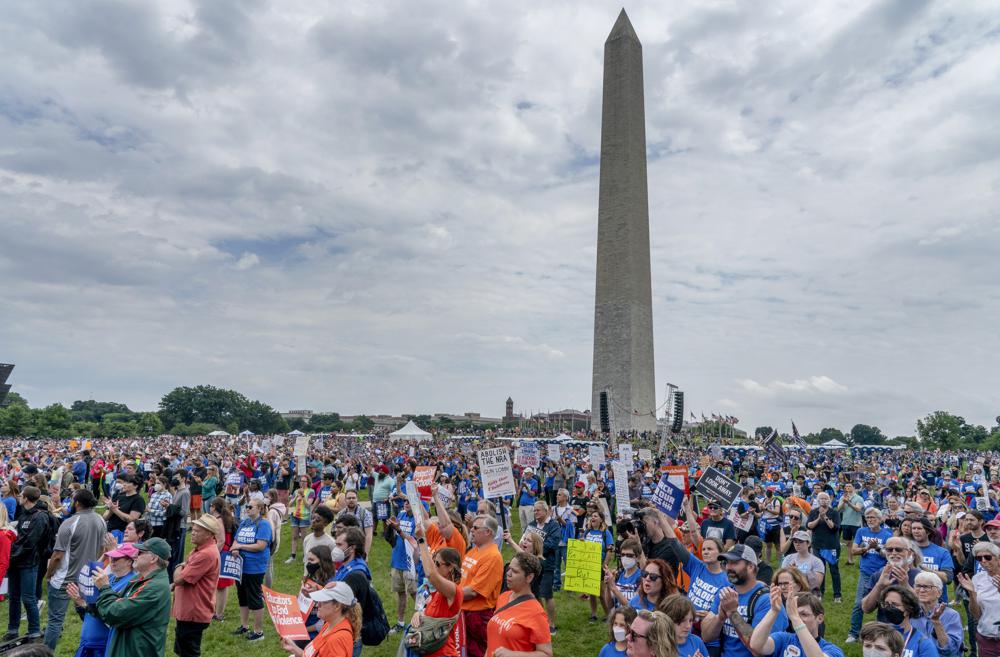The outline of a bipartisan Senate agreement to rein in gun violence has no game-changing steps banning the deadliest firearms. It does propose measured provisions making it harder for some young gun buyers, or people considered threatening, to have weapons.
And there are meaningful efforts to address mental health and school safety concerns. It all reflects election-year pressure to act both parties feel after mass shootings in May killed 10 people in Buffalo, New York, and 21 more in Uvalde, Texas.
Details of the plan remain in negotiation between Democrats and Republicans, with disagreements over how tightly the initiatives should be drawn. That means the proposal’s potency — and perhaps whether some parts survive — remain undetermined as it’s translated into legislation.
Here’s what’s in and out of the agreement:
A STRENGTHENING, NARROWLY, OF BACKGROUND CHECKS
When people age 18 to 20 try buying firearms, the required federal background check would for the first time include their juvenile crime and mental health records. To allow time for getting data from state and local authorities, the process’ current three-day maximum would be extended up to seven more days, according to aides following the talks. Once the 10 days lapse, the buyer could get the weapon, even if the record search is incomplete.
Currently, dealers considered in the “business” of selling guns are required to get federal firearms licenses. Such sellers must conduct background checks. Bargainers want to cover more people who, while not running a formal business, occasionally sell weapons.
OTHER MEASURED CURBS
The framework calls for grants to help states enforce or enact “red flag” laws that let authorities get court orders temporarily taking guns from people deemed dangerous. Nineteen states and the District of Columbia have such statutes, but some lack funds to enforce them robustly.
Penalties would be toughened for so-called straw purchasers, those buying guns for others who don’t qualify. More current or former romantic partners convicted of domestic abuse, or targeted with restraining orders by their victims, would be barred from getting guns. The ban applies today if the couple was married, lived together or had children together.
Inclusion of the tougher restrictions against straw purchasers and estranged partners were surprises because they’d been blocked by Republicans before.
ADDRESSING BROADER PROBLEMS
Democrats say there will be billions of dollars to expand mental health initiatives. This would pay for more community behavioral health centers, strengthened suicide prevention and violence intervention efforts and increased access to mental telehealth visits.
There would be new sums for school safety. These could include better security at building entrances, training for staff and violence prevention programs. The dollar amount is unclear.
HURDLES AHEAD
Democrats responsive to constituents who strongly favor gun curbs want the new law to be as stringent as possible. Republicans want nothing that would turn their adamantly pro-gun voters against them.
This means tough bargaining on the fine print of the legislation.
How narrowly will a new definition of which sellers need federal firearms licenses be written? Are there limits on which juvenile records would be accessible during background checks for younger buyers?
What conditions would states have to meet to qualify for “red flag” funds? What legal protections would people have if the authorities consider them too risky to have firearms?
How much money will the package cost? No one has said, though people familiar with the discussions say a ballpark $15 billion is possible. And how will it be paid for?
A leader of the effort, Sen. Chris Murphy, D-Conn., told reporters Monday that bargainers plan to pay for the costs with offsetting spending cuts or new revenues. The latter could be a no-go for Republicans.
Leaders hope the package can be written and approved before Congress begins its July 4 recess.
WHAT’S OUT?
President Joe Biden has proposed reviving the 1994 assault weapons ban, which expired after a decade, or raising the minimum age for buying one from 18 to 21. He wants to ban high-capacity magazines.
He’d repeal the legal immunity from liability protecting gun makers. He wants safe storage requirements for guns and a federal “red-flag” law to cover states without one.
None of those made it into the bill; nor did universal background checks. Biden backs the agreement anyway in the name of a compromise that would produce an achievement.
PROSPECTS AHEAD?
Ten senators from each party joined in announcing the gun outline and saying they backed it. Those numbers are not a coincidence.
They signal potentially enough support for passage by the 50-50 Senate, where Democrats will need at least 10 GOP backers to reach the usual 60-vote threshold. Besides Murphy, the other lead negotiators were Sens. John Cornyn, R-Texas, Kyrsten Sinema, D-Ariz., and Thom Tillis, R-N.C.
Approval in the Democratic-run House is expected, though complications could always emerge.
MORE RESTRICTIONS?
Another bargainer, Sen. Richard Blumenthal, D-Conn., said he hopes Republicans will see that “the gun lobby is weaker than they think.” But there are signs that approving future restrictions will be challenging.
For one thing, this spurt of action on guns is Congress’ most significant since the now-expired assault weapons ban was enacted three decades ago. That spotlights how hardened positions can be lasting.
Another clue is the makeup of the agreement’s 20 announced supporters. Blumenthal and Sen. Mark Kelly, D-Ariz., are the only two running for reelection this year.
Four others, all Republicans, are retiring in January: Sens. Roy Blunt of Missouri, Richard Burr of North Carolina, Rob Portman of Ohio and Pat Toomey of Pennsylvania.
The rest don’t face reelection until 2024 or 2026.
They are Republican Sens. Bill Cassidy of Louisiana, Susan Collins of Maine, Lindsey Graham of South Carolina and Mitt Romney of Utah.
The Democrats are Sens. Cory Booker of New Jersey, Chris Coons of Delaware, Martin Heinrich of New Mexico, Joe Manchin of West Virginia and Debbie Stabenow of Michigan.
Independent Sen. Angus King of Maine, allied with Democrats, also backed the proposal.
(AP)












One Response
1. When people age 18 to 20 try buying firearms, the required federal background check would for the first time include their juvenile crime and mental health records.
This should have been done from the beginning. And not just for those under 21. Juvenile records and mental health records should be in the NCIS system as a matter of course.
2. To allow time for getting data from state and local authorities, the process’ current three-day maximum would be extended up to seven more days,
This is not acceptable. 3 days is itself a painful compromise, but that should be the maximum allowed. 10 days’ delay to exercise a fundamental constitutional right is intolerable. Imagine making someone wait 10 days before being allowed to buy a newspaper.
3. Bargainers want to cover more people who, while not running a formal business, occasionally sell weapons.
This is not acceptable. Dealers are regulated. If someone is not a dealer, it is none of the government’s business what he does, and it should not be allowed to impose onerous and costly requirements on him, which may wipe out entirely the benefit of selling the weapon. Can you imagine imposing on anyone selling a used car the same requirements that are required of full-time dealerships?!
4. The framework calls for grants to help states enforce or enact “red flag” laws
“Red flag laws” will only be acceptable if they provide the target with advance notice, a judicial hearing within 3 days (not 14!), the right to confront the evidence and the accuser, legal representation if he can’t afford it, access to mental health care if he is adjudged dangerous, regular status review (at least every six months), and a civil cause of action against false accusers. Right now, NONE of these conditions exist, in any of the states with such laws.
5. Penalties would be toughened for so-called straw purchasers,
What’s the point, when straw purchasers are almost never prosecuted? The penalties are plenty tough as it is; but they have no effect if they’re never enforced. Better still, prosecute people who fail the background check. Attempting to purchase a weapon when one knows one is banned from doing so is a crime; why are there no prosecutions for it? There is only one obvious answer: Because prosecutors know that most or all such cases are false positives, and trying to bring charges would force them to disclose this information.
6. More current or former romantic partners convicted of domestic abuse, or targeted with restraining orders by their victims, would be barred from getting guns. The ban applies today if the couple was married, lived together or had children together.
If a couple have never been married, lived together, or had a child together, then in what sense are they a couple? In what sense is violence between them “domestic”? Of course anyone convicted of a violent felony is already barred, so this only applies to misdemeanors — and to those targeted by restraining orders, which are often ex parte and completely invalid. It is unconstitutional to disarm someone just because their ex-friend made an accusation against them.